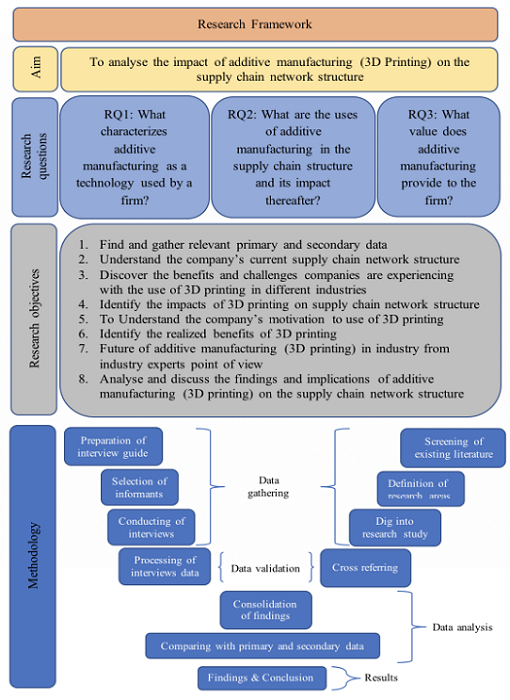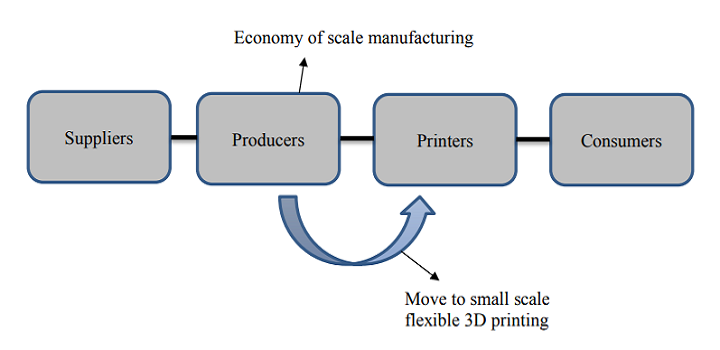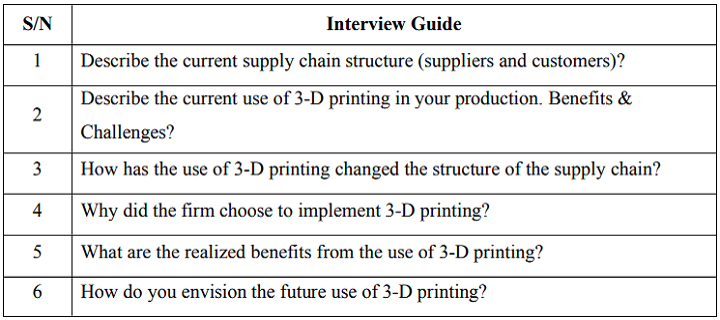Thesis Paper Looks at 3D Printing in the Supply Chain to Determine if it Truly is a Disruptive Technology
 Two master’s students, Maryam Salman and Waqas Mushtaq, at the Norwegian University of Science and Technology (NTNU) completed a thesis paper together about the structure of the supply chain network and if additive manufacturing can be considered a disruptive technology in business. The paper, titled “Impact of Additive Manufacturing on Supply Chain Network Structure,” is essentially a study of 15 different Norwegian firms and their use of additive manufacturing.
Two master’s students, Maryam Salman and Waqas Mushtaq, at the Norwegian University of Science and Technology (NTNU) completed a thesis paper together about the structure of the supply chain network and if additive manufacturing can be considered a disruptive technology in business. The paper, titled “Impact of Additive Manufacturing on Supply Chain Network Structure,” is essentially a study of 15 different Norwegian firms and their use of additive manufacturing.
The two co-authors interviewed and observed the companies in order to provide detailed case studies and, as the paper states, “empirically ground the networked use of additive manufacturing.”
“This study has proven to be a great way to learn about new subjects and gain a comprehensive understanding of the mechanisms involved in production, supply chain network structure, impact of additive manufacturing on network structure and the degree to which additive manufacturing can be considered as a disruptive innovation,” Salman and Mushtaq wrote in the preface of their paper.
They conducted the qualitative interviews to learn each company’s history and current use of 3D printing, along with any potential future use.
“The research is founded in supply chain management literature providing focus on how companies integrate to collaborate and coordinate production processes in an industrial network,” the researchers wrote. “Proximity to customers is a key analytical factor in the studied networks to facilitate co-creation. This implies considering new business models focusing on proximity in business relationships as a key factor associated with organizing supply.”
 The Norwegian companies the team interviewed, and in several cases visited for observation, are:
The Norwegian companies the team interviewed, and in several cases visited for observation, are:
- Kongsberg, maritime division
- Kongsberg, defense & aerospace division
- Ekornes ASA
- Pla-Mek AS
- Stokke AS
- Sperre Industri AS
- Tronrud Engineering AS
- Plasto AS
- AS OM BE Plast
- Isiflo AS
- Norsk Titanium AS
- Nordic Additive Manufacturing AS
- Panalpina Ltd
- Glamox AS
- Fosstech AS
3D printing has been revolutionizing the manufacturing industry, as it offer benefits such as design flexibility, reduced manufacturing cost and time and material waste, and lightweight, stronger parts. As a result, many companies in countless industries have added the disruptive technology to their own supply chains. But, as there are still barriers to adoption, this thesis asks if 3D printing really can be considered disruptive.
The researchers stated, “The purpose of this thesis is to analyse the impact of additive manufacturing on supply chains and how they alter the network structures among the supply chains once implemented.”
The study covered three main areas: 3D printing, its effects on the structure of the supply chain, and the value add to using the technology. In order to follow a structured approach for the study, three specific research questions comprised the objective of the thesis:
- What characterizes additive manufacturing as a technology used by a firm?
- What are the uses of additive manufacturing in the supply chain structure and its impact thereafter?
- What value does additive manufacturing provide to the firm?
Analysis of the interviews was based on personal judgement by the two researchers, as well as previous literature about 3D printing and the supply chain.
One of the last sections of thesis summarized the findings from all of the interviewed companies. Several of them use 3D printing for prototyping and product development, though a few, like Norsk Titanium, are actually 3D printing commercial end-use parts. The companies that only use 3D printing for prototyping are listed as having a low impact value for the technology, as it is not yet affecting the supply chain.
“Most of the firms started to explore this technology because of the vast opportunities and new possibilities that it has to offer. So, that they can stay ahead with the technology and compete in the market. Many of the firms that we interviewed began with product development and prototyping and used it as a rapid prototyping tool, with only few using it in commercial production,” Salman and Mushtaq wrote.
“But the overall impact of additive manufacturing on the supply chain structure has been minimal. Out of 15 companies, 12 stated that they did not experience any significant change on the structure of their supply chain networks. Only 3 companies mentioned the change in their supply chain which include an increase in the number of suppliers and customers, reduced supply chain complexity and delay, and shortened time to market.”
However, the researchers did note that each of the 15 companies was optimistic about future use of 3D printing, and could foresee “enormous potential in manufacturing and supply chain,” as the technology continues to improve over time. Salman and Mushtaq concluded that their study shows that the overall use of 3D printing in supply chains is limited, making it “still in its infancy technologically.”
“It can at this point in time not be considered as a disruptive innovation due to its current limited use in the supply chain of the studied firms,” the researchers concluded.
What do you think about the results of this study – do you agree or disagree? Discuss this research and other 3D printing topics at 3DPrintBoard.com or share your thoughts in the Facebook comments below.
Subscribe to Our Email Newsletter
Stay up-to-date on all the latest news from the 3D printing industry and receive information and offers from third party vendors.
You May Also Like
3D Printing Unpeeled: Biofuel Waste to Filament & Sustainable Photopolymers
I can’t ever remember a day with so many potentially high impact news stories have come out. In one story, we all know that there are problems with the safety...
Finnair Hires AM Craft to 3D Print Plastic Parts for Aircraft Interiors
Riga-based AM Craft, a supplier specialized in 3D printing aviation components and certified under EASA Part 21G, announced a significant achievement today. The company will assist in upgrading Finnair’s A320...
3DPOD Episode 198: High Speed Sintering with Neil Hopkinson, VP of AM at Stratasys
Neil Hopkinson, a pioneering 3D printing researcher, played a pivotal role in developing a body of research that is widely utilized today. He also invented High Speed Sintering (HSS), also...
3D Printing Webinar and Event Roundup: May 12, 2024
Webinars and events are picking up in the AM industry this week! ASTM International continues its Professional Certificate Course and Stratasys continues its advanced in-person trainings, while 3D Systems is...


































